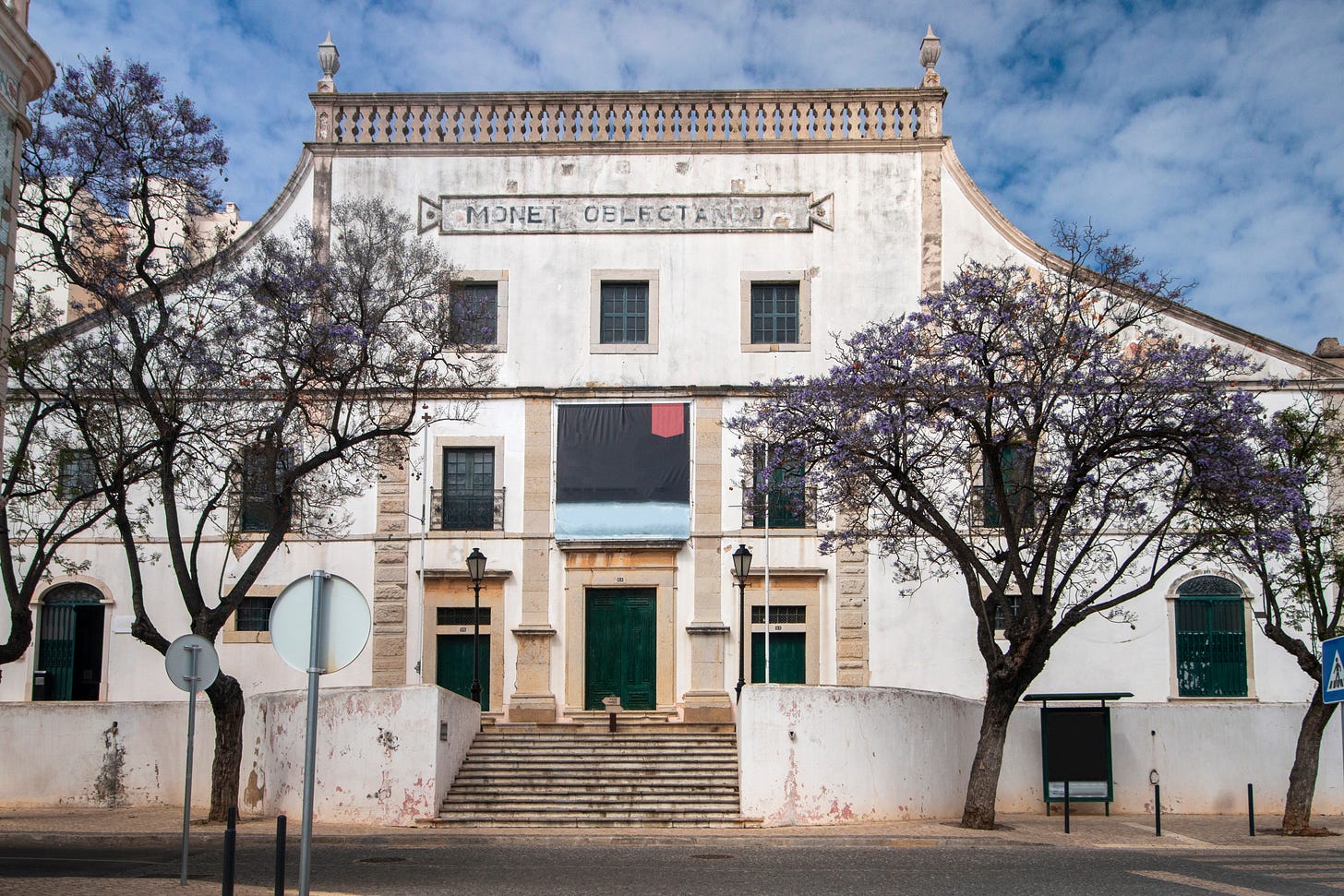Seven Haunted Places in Portugal
A Halloween Journey into the Supernatural

Today, October 31st is the eve of All Saints' Day and the celebration of Halloween by many cultures - a day when legend says that the spirits of the dead rise and wander the earth as ghosts, ghouls, and demons, mingle with the living for a single night.
In the spirit of the season, I thought it would be fun to explore some of the infamous haunted locations in Portugal and take a glimpse into the legends behind them.
Here are seven sites that are rumored to be haunted by ghosts, spirits, and other paranormal entities:
1. Palácio da Regaleira, Sintra, Portugal

Palácio da Regaleira, also known as Quinta da Regaleira, is one of Sintra’s most mysterious and intriguing sites. Designed and built in the late 1800’s, this gothic-style palace is filled with occult symbols, secret passageways, and subterranean tunnels. It is often associated with freemasonry, alchemy, and the Knights Templar. The most eerie feature is the Initiation Well, a spiraling underground tower that descends into darkness. Many visitors report feeling an unsettling presence while wandering through the gardens, particularly near the well.
Some visitors claim to have seen shadowy figures walking the gardens and heard disembodied whispers echoing through the tunnels. Others report feeling an oppressive, heavy energy near certain symbols, suggesting the spirits of past secretive rituals may still linger.
2. Quinta das Lágrimas (Estate of Tears), Coimbra, Portugal

Now a luxury hotel, the estate of Quinta das Lágrimas is most famously linked to one of Portugal’s most enduring love stories—that of King Pedro I and his beloved Inês de Castro—whose tragic tale fuels the estate's ghostly reputation.
Inês de Castro was a lady-in-waiting to Princess Constanza, wife of Pedro, the future King of Portugal. Pedro and Inês fell deeply in love, beginning a secret relationship that would lead to political and personal tragedy. After the death of Princess Constanza, Pedro wished to marry Inês, but his father, King Afonso IV, opposed the union, fearing her influence and the threat her family posed to the throne.
Despite his father’s orders, Pedro continued his affair with Inês. Fearing her growing power, Afonso IV ordered her assassination in 1355. Inês was brutally murdered in the gardens of Quinta das Lágrimas. Devastated by her death, Pedro eventually took the throne and, according to legend, exhumed Inês’s body, crowned her queen, and forced his courtiers to kiss her decaying hand as an act of homage.
Many believe that the restless spirit of Inês de Castro still roams Quinta das Lágrimas, unable to find peace due to her violent death. The Fountain of Tears (Fonte das Lágrimas), a natural spring that runs through the estate has become a focal point for the supernatural stories associated with Inês’s death. According to legend, the blood of Inês was spilled into the waters of this fountain, and her tears are said to have permanently stained the rocks with red. Some claim to see her ghostly figure weeping by the water, while others hear her cries carried on the wind.
3. Valongo Sanitorium, Valongo, Portugal

The Valongo Sanatorium built in 1910 on top of Mont’Alto in the Serra de Santa Justa, near Porto was active from 1958 to 1975. It was the last of its kind in Portugal. Despite an initial capacity of only fifty beds, the hospital was regularly overcrowded with about 350 patients. The sanatorium primarily treated individuals with tuberculosis, many of whom endured tragic deaths within those walls. After its closure, the building was looted, vandalized, and suffered damage from fires. Today, it remains abandoned, and its grim past has given rise to numerous legends and rumors of ghosts and paranormal activity by patients who died there.
4. The Cemetery of Pleasures (Prazeres Cemetery), Lisbon, Portugal

One of the most interesting places to visit in Portugal is the Cemetery of Pleasures. Its name originates from a time when the area’s grassy plains hosted a lively fair. However, as the city expanded, the fair disappeared, and like many European cities, tombs eventually replaced the festivities.
These tombs are above ground and resemble small houses, creating a village-like appearance for the dead. Some of the tombs even have windows, offering a view inside. Over time, as coffins deteriorate, it is possible to catch glimpses of the remains. Among the many interred here are a group of firefighters who lost their lives battling a great city fire. While the cemetery is a peaceful place to honor the deceased, its haunting ambiance and unusual features certainly add to its ghostly charm.
Even if you are not into the eerie, this cemetery is still worth a guided tour visit for its historical and artistic value.
5. Teatro Lethes, Faro, Portugal

This historic theater that dates to the 19th century, is renowned for its classical architecture and rich cultural significance. Originally built as a Jesuit college in the 1600s, it was later converted into a theater in 1843, making it one of the oldest in the Algarve region.
Over the years, stories have emerged about the theater being haunted, with reports of strange occurrences and ghostly apparitions. Some claim to have seen the figure of a woman in old-fashioned clothing wandering backstage, while others have heard unexplained footsteps echoing through the empty halls. These eerie tales, coupled with the theater's old-world charm, add a mysterious allure to the already atmospheric venue, drawing both theater lovers and ghost hunters alike.
According to legend, a ballerina, overwhelmed by unrequited love, took her own life in this theater in Faro, Algarve. It is said that even now, she continues to dance on the stage.
Looking for a ‘Bone-Chilling’ Experience? Read my post about the Chapel of Bones.
6. Castelinho de São João do Estoril, Estoril, Portugal

Perched on a cliff above the blue waters of Cascais Bay and the Atlantic Ocean, this coastal mansion (privately owned and not open to the public), built in 1927 in the neo-Gothic style, has long been famous and is rumored to be haunted. Paul and I drive past this little castle all the time and often wondered what it was.
The Castelinho de São João do Estoril (also known as Castelinho Nossa Senhora de Fátimo), is reputedly haunted by the ghost of a little blind girl who met her fate after accidentally falling from a nearby cliff. It is said that her spirit now haunts the area as she roams the grounds holding a doll.
7. Convent of Mafra, Mafra, Portugal

The Convent of Mafra is steeped in legends that attempt to explain the eerie sounds echoing throughout the building. Some attribute the noises to bizarre, mutated creatures (giant, allegedly man-eating rats) said to inhabit the tunnels beneath the palace. Others believe the sounds come from the restless spirits of workers who perished during the convent's construction, victims of unsafe labor conditions, still seeking revenge for their untimely deaths.
Do you have a favorite haunted place in Portugal. Leave a comment and tell me about it!
Thank you for reading Our Portugal Journey. This blog is a subscriber supported publication but has no paywall – in other words, you can subscribe for free and receive all the content. However, if you find my content valuable, please consider becoming a Supporting Subscriber for a nominal fee either on a monthly or annual basis right here. Just want to buy me a glass of wine? You can do that here.
A Special Thank You to JuliahM for becoming a Supporting Subscriber and to Sandra N. for supporting my work through Buy Me a Coffee. I truly appreciate it!
Until next time…
Obrigada!
Carol.



Really enjoyed this piece! I’ve always been intrigued by the things we can’t see but are there in another dimension.
Great post! Just more information about the story of Pedro and Inês. In medieval ages (not only then, of course, later and before, too), kings and princes had all the power and the king's/prince's mistresses had great influence and importance. Pedro «lived» with Inês, they travelled through the country together (as kings/princes did then) and they had four children together, that had all the privileges of being king's children. Do read some more about them, 'cause it's a truly gruesome story (her murderers and king Pedro's actions...).